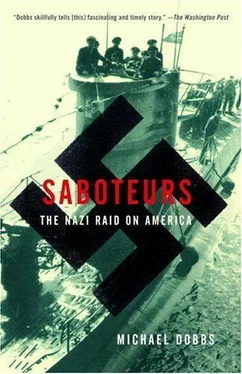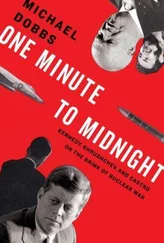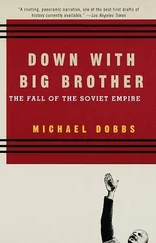Some of the dialogue sounded like the rants they had heard from Kappe at Quenz Lake. “You are the first Germans to set foot on Canadian soil,” the fictional U-boat captain told the six men who went ashore on a reconnaissance mission, thereby escaping the destruction of the submarine. “Today Europe, tomorrow the world. Heil Hitler.”
Other characters poked fun at Nazi ways:
FRENCH-CANADIAN TRAPPER [played by Laurence Olivier with an atrocious French accent]: Do you really march around Berlin doing this? [Mimics Heil Hitler salute and Nazi goose step.]
NAZI INVADER: Yes, we do.
Far from helping the two real-life saboteurs feel more relaxed, the movie deepened their already strong sense of isolation and paranoia. One scene depicted the leader of an ethnic German community providing food and shelter to his compatriots from the U-boat while denouncing their Nazi ideology. Another showed the fictional invaders trapped in a crowd of civilians as a Royal Canadian Mountie read their descriptions over a loudspeaker. “Look closely at your neighbor,” the stern voice urged, as thousands of eyes bore into the faces of the fugitives. “Sooner or later, their nerves will crack and they will give themselves away.”
After the movie, Haupt and Neubauer went to a restaurant next door for a meal, but soon felt uncomfortable. “Let’s get away from here,” said Haupt. “We may be watched by the FBI.” 19As they walked to Grant Park by the side of the lake, Neubauer said he was so nervous he was unable to sleep. He had to force himself to eat. “I don’t see how we are going to go through with this,” he murmured.
There was little Haupt could do to help Neubauer. They agreed that any decision about Operation Pastorius would have to wait until after July 6, when Kerling arrived in Chicago, following his meeting with Dasch in Cincinnati. In the meantime, Haupt and Neubauer would meet again on Wednesday at 1 p.m., outside the Chicago Theater.
Haupt spent the evening at the Froehling house, avoiding an FBI stake-out of his parents’ place at 2234 North Fremont Street. 20By the time he got home, it was nearly ten o’clock. After a wasted day outside the Haupt apartment, the G-men had left for the evening.
EDDIE KERLING and Werner Thiel arrived in New York around noon on Sunday, about the time that Haupt and Neubauer were making arrangements to meet at the Chicago Theater. They had taken a roundabout route. From Jacksonville, they had traveled separately inland to Cincinnati because they believed that the FBI was keeping a much closer watch on direct trains up the East Coast. After meeting in Cincinnati on Saturday afternoon, they had taken the overnight train to New York.
From New York’s Grand Central Terminal, they walked across the street to the Commodore Hotel, an ugly hulk named after the steamboat and railroad king Cornelius Vanderbilt. 21Among other attractions, the hotel boasted “the world’s most beautiful lobby,” which looked like a drawing room in the middle of the Amazon jungle, full of ferns and palm trees. Kerling registered under the name of Edward Kelly, while Thiel gave his name as William Thomas. Exhausted by the all-night train ride, they went up to their shared ninth-floor room, lay down on their beds, and immediately fell asleep. They did not awake until early evening.
Of all the saboteurs, Kerling was the most enthusiastic Nazi. He professed to like Americans, but he was scathing about their fighting abilities. America, he felt, was a weak, deluded nation that had been tricked into going to war with Germany by “a small group of Jews.” 22Kerling expanded on these ideas in a letter to an American girlfriend, Miriam Preston, written two weeks before Pearl Harbor:
To us it does not matter what Mr. Roosevelt intends to do. We are prepared for everything. You have no idea in America what your soldiers would have to put up with. I know America well. I know what you can put against us, but please believe me, Miriam, I feel sorry for the American soldier, for your brother, if he should have to fight against the German army. Russia had an army which had been trained for at least 10 years to fight us. Look what happened. I don’t underestimate the courage of the American boy by no means, but against tactics, training and invasion of the kind you have never seen—he is a helpless child. Miriam, we are in for a struggle for life or death. We know it— that is why our spirit can’t be beaten and why we are winning. 23
But now that he was actually back in New York, what most preoccupied Kerling was not Nazi Germany’s struggle for survival, but his exceptionally complicated personal situation. For the past ten years he had been married to a woman named Marie; they had worked together as a chauffeur-and-cook couple for wealthy Americans like Ely Culbertson, the contract bridge expert. But Marie was unable to bear children, and Kerling had a wandering eye. 24He was a handsome man with a strong physique, heavy jaw, wavy brown hair parted in the center, and a boyish enthusiasm that struck some women as romantic. While in Florida, on the yacht Lekala, he had met a Miami waitress named Hedwig Engemann, who became his mistress.
Marie Kerling did not object to this arrangement. She regarded her husband as a friend rather than a lover and, after his return to Germany in June 1940, she began seeing another man. She encouraged Eddie to divorce her and marry Hedy, so he could have children of his own. Kerling, however, was not so sure. He felt “carefree and content” when he was with Hedy, but he had belatedly come to realize that he loved his wife. She had a “heart of gold,” and he wanted to make things up with her. 25The truth was he needed both Marie and Hedy.
The man who could help him resolve this conundrum—or at least put him in touch with both women—was an old Bund comrade, Helmut Leiner. Leiner, who had worked as a gardener on Long Island, lived in the Queens neighborhood of Astoria. On Sunday evening, after he woke up from his nap, Kerling took a subway to Astoria with Thiel. Since Kerling did not want to be seen by Helmut’s parents, and risk embarrassing questions about how he got back from Germany, he sent Thiel on ahead to contact his friend. Thiel arranged for Kerling and Leiner to meet on the street. 26
Leiner was a sick man. He was recovering from a bad bout of tuberculosis, and had only been released from the hospital three days earlier. But he agreed to accompany Kerling and Thiel back to Manhattan, and have dinner with him at the Blue Ribbon, a German restaurant just off Times Square. After dinner, all three men went to the Tavern Inn, a few doors down the street, where they spent the next three hours downing a succession of Tom Collinses, gin and sour mix with ice and a splash of soda. Leiner gave Kerling an update on Marie, who was working as a cook for a wealthy family in Midtown, and Hedy, who was running a grocery store on Second Avenue. He promised to arrange meetings with both women.
Kerling trusted Leiner completely. He trusted him so much that he had selected him as a possible point of contact with Dasch. Exactly one month earlier, on May 21, in the Abwehr laboratory in Berlin, Dasch had written Leiner’s name and address on a handkerchief in invisible ink, in case he needed to get in touch with Kerling in an emergency. Although Kerling had no means of knowing it, that handkerchief was now in the possession of the FBI.
WHILE KERLING was looking for his old friend Leiner in Astoria, Dasch was having an early dinner with Duane Traynor at a Washington seafood restaurant called O’Donnells, a favorite haunt of FBI men. He was feeling “rather depressed,” he told Traynor. He feared that the U.S. government would not permit him to undertake his “main mission,” which was to aid the German people in overthrowing Hitler. 27If he could not accomplish this goal, he might as well be “shot as a traitor and a spy.” Otherwise, he would find a way to take his own life. The next day, Traynor wrote a memo analyzing the split personality of the saboteur-turned-informant.
Читать дальше












